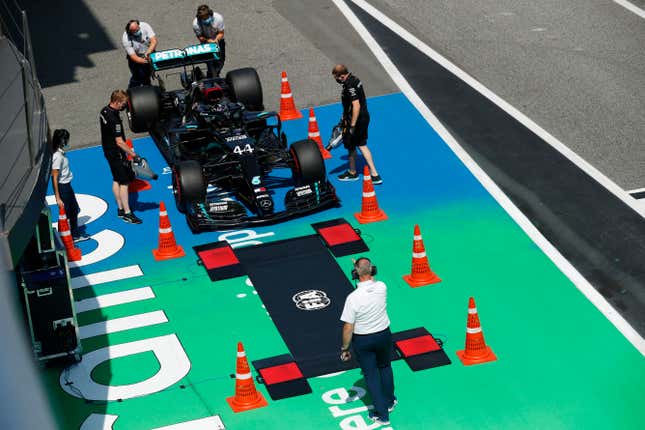Formula 1 is considering ditching the current 18-inch wheel size after only two seasons in a drive to reduce the weight of cars across the championship field. F1’s stakeholders aim to take 110 pounds off of the cars when new regulations are introduced in 2026. The chassis dimensions will already be trimmed for the next rules cycle as the drivers aren’t fans of the relatively huge machines. However, that target is becoming more and more unrealistic as the deadline approaches.
According to Motorsport.com, the 2026 wheel size would fall between the current 18-inch wheel and the previous 13-inch rim with 16 inches being the leading contender. For comparison, IndyCar currently uses 15-inch wheels. Last year’s increase added 30.8 pounds to the car and a reduction to compromise size would create other knock-on effects. The FIA’s single seater chief Nikolas Tombazis told the website:
“With the dimensions of the wheels, which will be narrower, plus with the rear wing and the car in general, we aim to reduce the weight of the cars by around 50kg. So, it will be possible to see smaller single-seater cars: shorter and narrower. But we are talking about solutions that still need to be discussed.”
“With the car on a diet, we will be able to reduce the cornering speeds a bit. Being lighter, they will go faster in a straight line, but will generate less aerodynamic load. So, we will need to increase the hybrid’s energy recovery to ensure adequate lap performance.”

Trimming a couple of inches from the chassis’ wheelbase and width will yield some progress towards the goal. However, F1 will come nowhere close to melting 110 pounds away. These cars have gained over 340 pounds over the last decade. Additional anti-intrusion panels and the Halo crash protection structure were added to F1 machinery, but the most significant increases were performance-related.
Turbo-hybrid monsters that shattered lap records at nearly every circuit on the schedule came with a cost. The current turbocharged 1.6-liter V6 engines produce 1,000 horsepower, but the battery pack for the hybrid system weighs almost 90 pounds. The combustion engines themselves have to adhere to a 330-pound weight limit. The aerodynamic changes were just the rotten cherry on top of the scale that also made wheel-to-wheel racing even more difficult.

Mercedes’ technical director James Allison would just like the arbitrary weight decrease and have the teams find a way to cut down to the minimum. The method would undoubtedly help Mercedes, a constructor under the limit before 2023, but it would introduce a variable that could endanger the drivers.
Yes, the weight limit includes a driver allowance to prevent teams from forcing their employees to starve themselves. However, teams cut corners and put people out on track in danger to save a couple of ounces. The most startling recent example was when Zhou Guanyu’s roll hoop sheered off as his Alfa Romeo slid upside down during his crash at the 2022 British Grand Prix.
If Formula 1 seriously wants to reduce the size and weight of its car, the championship has re-evaluate its entire technical regulations. Small amendments aren’t going to reverse this decades-long trend.

